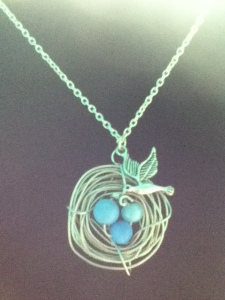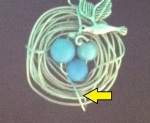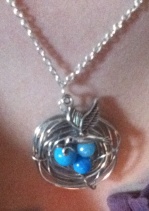This necklace is really easy. And it’s pretty much foolproof, since a large part of the process is just sort of crinkling up and making a bunch of wire look messy. I liked adding a bird charm on mine, and after making this first one, I tried different variations of the same necklace with different color beads and wire. For the next one, I used thick brown wire and three pearls for the eggs.
What you need:
-a few feet of 20-24 gauge wire. It needs to be thick enough for you to bend with your fingers, but tough enough that it stays in place after the necklace is made and while it is actually being worn. I believe I used 22 gauge.
-three beads of similar size that represent the bird’s eggs
-desired amount of necklace chain and clasp
-bird charm (I guess this could be optional)
-basic jewelry making tools
1.) You begin by stringing each bead onto the end of the wire, kinking the wire between each bead so they sit in a circle.
2.) Then, with the remaining wire, wrap a circle out of the wire around the outer edge of the beads. Mine was about an inch and a half in diameter. Keep wrapping around this original circle, but try to vary the circles slightly. Make some slightly larger, some crooked, some smaller, so the end result is a sort of messy bird’s nest.
Make sure to wrap a little extra on the back so the back of the necklace is heavier than the front. The first nest necklace I made has a tendency to flip over (the eggs like to gravitate towards me) because they are so heavy. On the second one, I made sure to compensate for this by making the back heavier with extra wire. Just something to keep in mind.
3.) When your nest looks adequate in thickness, wrap a few last pieces in and out of the middle hole to hold the nest together. These are almost perpendicular to the wires of the circle, but should appear to be sort of loosely holding the whole thing together.
4.) Attach jump-ring to perpendicular wrapping at what will be the top of the nest. Attach another jump-ring to this one, so the necklace will face the correct direction.
5.) Attach the bird charm if you have one you would like to use. I attached mine to the higher of the two jumprings.
6.) String the chain through the top jump-ring; attach clasp.
7.) Frolic in a meadow gracefully! Springtime!






